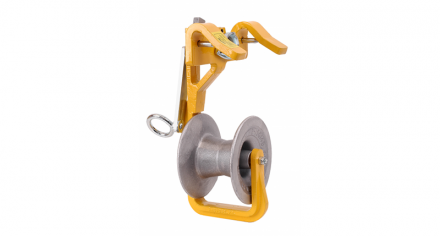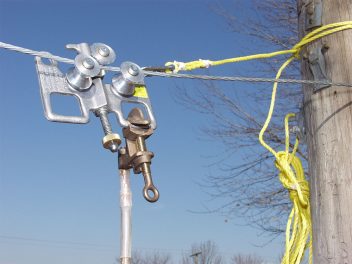In the world of Aerial Cable Placement, there are two methods that telecom workers must be familiar with: stationary reel and moving reel method. This guide will give you an overview on how these methods work and the tools used to execute them.
With the stationary method, the reel of cable remains in a single position, keeping it anchored to the ground. The cable is then pulled through the cable blocks along the strand, keeping the cable steady and supported. When should you use the stationary reel method? If you’re attaching the initial cable to a strand, then using the stationary reel method would be ideal (which would be considered New Construction). Or, if you’re attaching a cable to an existing lashed cable and strand, then the stationary reel method is the way for you to go (which would be considered Overlash Construction).
We’ll walk you through some tools to consider when executing the stationary reel method. There are specific tools for New Construction as well as tools that can be used for either New or Overlash Construction. But first, let’s talk about one of the most important things: The Cable Lasher. The most versatile cable lasher for decades has been the model J2 Lasher. It is often used interchangeably for new construction or overlash. But recently, a derivative of the J2 Lasher called the J2B has been gaining traction. The J2B is simply a J2 with a wider mouth opening at the front of the machine where the cable enters the drive housing and the elimination the strand lock assembly. On the J2 machine the strand lock can be rotated out of the way for overlashing, however, it still takes some room and can reduce clearance for passage of the largest bundle when overlashing. As a result, techs will sometime remove the strand lock altogether as is the case in the J2B Lasher. It is also worth mentioning that the smaller C Lasher was not really designed for overlashing. Enter the C2 Lasher which has been re-designed to be better suited to overlashing of cables in bundles up to 1.8 in. or 46 mm across. Full details on Cable Lashers can be found at https://www.gmptools.com/index-cable-lashers-wire-products/
Lashing Wire
Lashing wire comes in different stainless steel grades, diameters, and lengths. The 430 Stainless Steel Lashing Wire is for general use. The 302 Stainless Steel Lashing Wire has higher tensile strength than the 430 and can be used in harsher environments. The 316 Stainless Steel Lashing Wire is the most corrosion resistant of the three, so if you know your project is in a corrosive environment, such as near the seacoast, then opt for the 316 grade.
When estimating how much lashing wire is best for the job, use this following guide, but remember this is only a guide. Job requirements are bound to vary:
- Add 5% to length for Cable Bundles up to 11⁄2” in diameter.
- Add 10% to length for Cable Bundles ranging from 11⁄2” to 3” in diameter.
- Add 20% to length for Cable Bundles exceeding 3” in diameter.
New Construction Tools
When it comes to tools that will help you on the job, one tool to keep on your radar for New Construction is the 73305 Cable Block. This light-duty block is only used where the strand is 1⁄4” and the cable is under 1” in diameter. For more medium-duty construction, the 75000 Cable Block will be your best friend, able to support cable up to 23⁄4” in diameter on a 1⁄4” strand. This tool even comes with a bi-directional locking lever, which means that it will not move along the strand until you want it to.
New and Overlash Construction
For New and Overlash Construction, one tool to keep in your toolbox is the Clip-On Cable Block. This tool is used for more light-duty construction jobs and can support cables no bigger than 1” in diameter. It can also be used for both New and Overlash Construction, making it a versatile tool. If you’re looking for something that’s more suitable for medium-duty construction, then the 10700 or 10701 (aluminum or rubber roller respectively) Cable Blocks are the way to go. The frame is made out of cast aluminum, making it durable enough to support lashing of cables up to 2” in diameter. A big plus is that this too can be used for both New and Overlash Construction, as long as the pre-existing cable is less than 1” in diameter. There are larger cable block options as well. See the full line at: https://www.gmptools.com/index-cable-block-products/
The Moving Reel Method, also call the “drive off” method, involves the cable reel trailer or aerial placing vehicle being moved along the pole line rather than staying stationary. What are the conditions under which the moving reel method can be employed? When the pre-survey of the route has determined that there are no trees or other obstructions to prevent raising the cable to the suspension strand and there is access for the placing vehicle on the side of the pole where plant is to be placed. If you’re either placing an initial cable on a suspension strand, or if you’re lashing cable to an existing cable and strand then this method will work, exactly the same as the stationary reel method.
Just like the stationary reel method, the moving reel method can be used for both New and Overlash Construction.
The tools for Moving Reel Method do not require the use of cable blocks. The main difference is in the selection of aerial cable guides. There are guides for new construction or single lash, and another for overlashing. The single-lashing cable guide is the #70055 guide, and the overlashing guide is the #08007.
See https://www.gmptools.com/index-aerial-tools-equip-products/ for more information on aerial cable guides.
Other tools that will work for both New and Overlash Construction while using the Moving Reel Method are Cable Guards, to keep your cables in tip-top shape, a Lashing Wire Grip, and a D Lashing Wire Clamp.
Since 1936, General Machine Products has been a leader in supplying the telecom industry. Visit us today at gmptools.com or call us at 215-357-5500 to learn more about aerial cable placement solutions.





